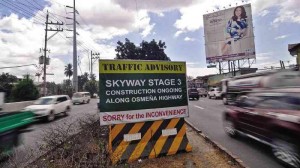
Photo shows a traffic advisory for the construction of the Skyway Stage 3 project displayed along Osmeña Highway in Manila. The Philippine construction sector is expected to sustain its strong growth in 2015, as the turnover in both public and private sector construction activities is seen to reach about P1.7 trillion. RICHARD A. REYES
MANILA, Philippines–The Philippine construction sector is expected to sustain its strong growth this year, as the turnover in both public and private sector construction activities is seen to reach about P1.7 trillion.
However, Manolito P. Madrasto, executive director at the Philippine Constructors Association Inc., said the forecast assumed that the government would be able to fully roll out the more than P500 billion infrastructure spending programmed for the year. The amount, he said, should be on top of the expected outlay for the implementation of the public-private partnership (PPP) projects that have already been awarded.
A more conservative estimate, according to Madrasto, would be a turnover of about P1.2 trillion that will largely be accounted for by the private sector. This forecast considered possibilities of certain government projects being stalled due to some controversies, as what had happened last year.
A country report issued by the PCA in February noted that “2014 has been a remarkable year for construction sector despite the underspending of the government that was consistently observed throughout the year.”
“Delays and/or suspension of government infrastructure projects due to several factors such as Supreme Court’s decision declaring that major provisions of Disbursement Acceleration Program (DAP) illegal and the slow progress in the construction and rehabilitation efforts for Yolanda-struck areas have pulled down the performance of public construction in the second and third quarters of 2014,” the report stated.
Public construction, it added, further went down by 6.2 percent in the third quarter of 2014 mainly due to government underspending.
“Overall, public construction had not reached the positive mark for the full-year 2014 due to these delays. Nonetheless, given the better revenue collection by the government in the recent months, there will likely be a large fiscal space to increase infrastructure spending for the next coming quarters,” the PCA said.
Despite the slowdown in the implementation of government and PPP projects, however, the private sector was able to significantly boost the growth of the construction sector last year.
Data from PCA showed that at current prices, the gross value of private sector construction projects grew by 16.3 percent to $25.613 billion (or P1.137 trillion) last year, bringing the total, including public sector activities, to $31.889 billion, or about P1.42 trillion.
At constant prices, the gross value in construction for both the public and private sectors grew by 10 percent to $14.455 billion, which was equivalent to P641.8 billion.
“It is expected that in the coming quarters or years, there will be a sustained increase in residential construction projects in a bid to revive the country’s housing market and meet demand from the growing population,” the report stated.
“To support this goal, the Housing and Land Use Regulatory Board (HLURB) has set a target to construct 1 million housing units by 2016, and also announced the construction of over 300 condominium projects in Metro Manila, most of which will be allocated to the mid-market segment. Meanwhile, residential sales will become stronger among the high-end market and foreigners, as they are more prone to leasing and renting property,” the PCA added.
Last year, the Philippine construction industry also contributed 5.8 percent (at constant prices) to the economy. It also accounted for 6.6 percent of total employment as of end October 2014.

